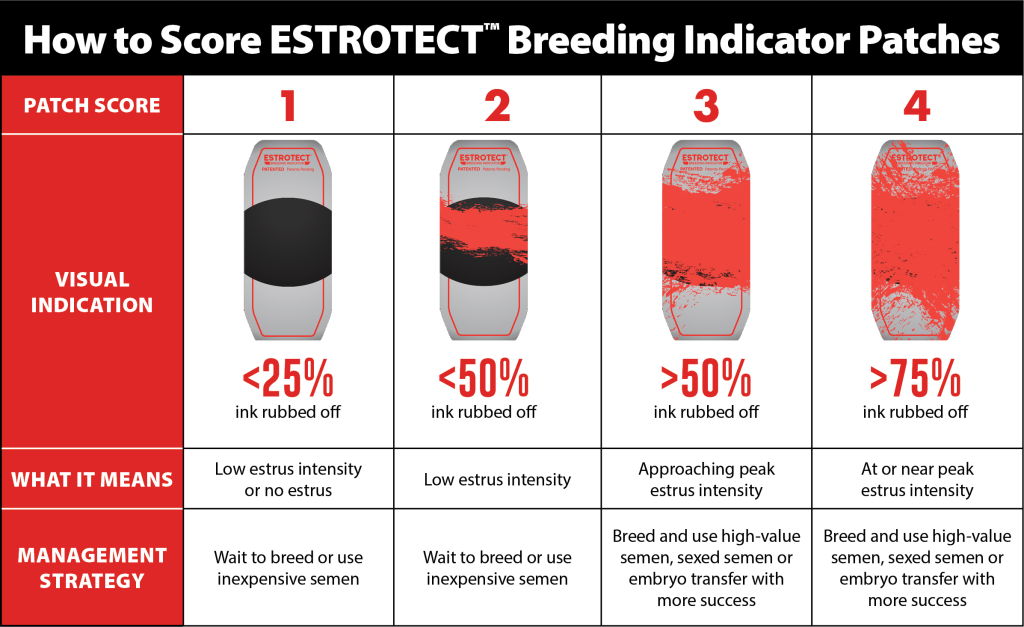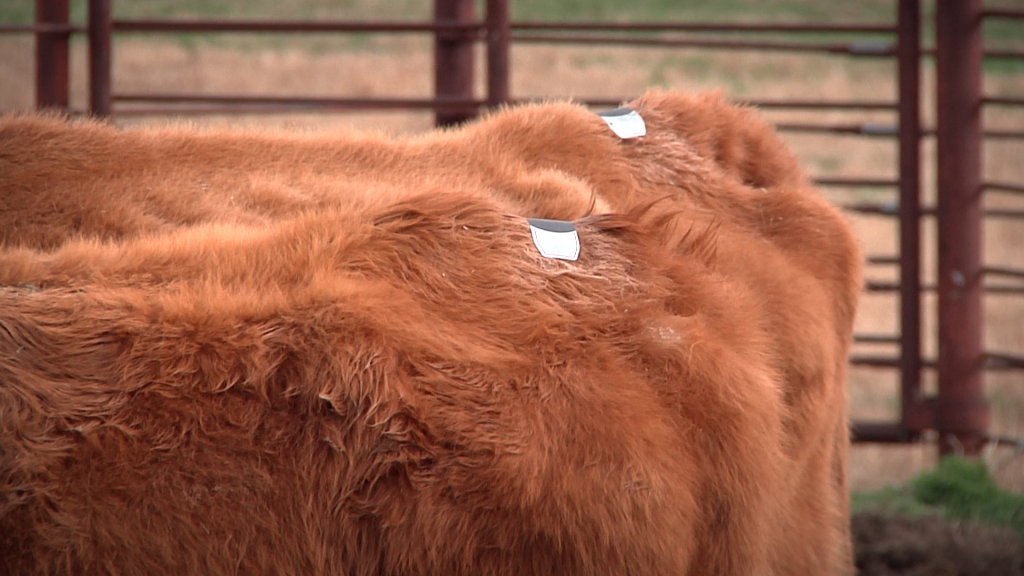Research shows that conception results with sexed semen can be drastically improved using estrus detection.
Provided by Estrotect
Either of these breeding goals can be achieved when using ABS Global’s Sexcel™ sexed semen through the Sexcel 60/40 Synch program.

The innovative breeding system uses a combination of fixed timed artificial insemination (AI) and estrus detection with Estrotect™ Breeding Indicators. The system was first successfully implemented in a South Dakota State University (SDSU) research study led by George Perry, now a beef cattle reproductive specialist at Texas A&M AgriLife Research.[1]
“A common misconception is that fertility decreases when breeding with sexed semen,” says Perry. “In reality, the drop in fertility is because of the cows and heifers that have no estrus activity.”
Improving the Outcomes
In 2017, while Perry was at SDSU, he led a USDA-funded study with the objective of seeing how far producers could skew a calf crop in terms of sex and its economic impact.
At the time of the initial study, sexed semen wasn’t implemented in many beef herds. Most researchers’ experience with sexed semen came from working with dairy herds.
“Our goal from the study was to see if we could successfully use the practice in commercial cow-calf herds,” says Perry.
Six different commercial herds in South Dakota with 500 head or fewer were identified to participate in the research study. Throughout three breeding seasons, the herds were transitioned from natural service with synchronization to timed AI before using sexed semen in the last breeding.
The study used Sexcel semen provided by ABS (available in dairy, and still in the research phases for beef at the time).
“It was a joint collaboration between SDSU and ABS to get more data for everyone, helping prove sexed semen works in beef herds,” says Perry.
Proof in the Results
The study found that pairing the Sexcel 60/40 Synch program with Estrotect Breeding Indicators could achieve conception rates near conventional semen.
Cows and heifers were synchronized using a 7-day CO-Synch plus CIDR protocol. Following CIDR removal, an Estrotect Breeding Indicator was applied to cattle for chute-side estrus detection at the time of AI.
A patch scoring protocol on a 1-4 scale based on the amount of the surface patch color rubbed off was used in the study and is now the recommended practice for Estrotect Breeding Indicators:
- Patch score 1 = less than 25% ink rubbed off (unactivated)
- Patch score 2 = less than 50% ink rubbed off (partially activated)
- Patch score 3 = greater than 50% ink rubbed off (partially activated)
- Patch score 4 = greater than 75% ink rubbed off (fully activated)

Final results showed cows and heifers bred with fully activated Estrotect Breeding Indicators to Sexcel semen resulted in conception rates that were 89% of the conception rates of conventional semen (i.e. animals that had activated patches had 65% conception rates with conventional semen they would have 58% with sexed semen). If the patch was unactivated, conception rates dropped to only 59% of conventional semen (i.e. animals that had unactivated patches had 45% conception rates with conventional semen they would have 26% conception rates with sexed semen).
“The research reinforced that producers who use sexed semen will have greater success with it when cows are showing estrus,” says Perry. “You can’t follow a fixed timed AI program and expect the same outcomes. You need to detect estrus, too.”
An economic analysis is still ongoing as the last calves from the project have entered feedlots and packing plants this year. Results are expected to be available later in the spring.
Words of Advice
With the proof that estrus detection can help achieve higher conception rates, the Sexcel 60/40 Synch program is being implemented on cattle ranches and farms.
“Sexcel is about improving overall ranch or farm profitability,” says Todd Sears, beef sales director at ABS. “We want you to be able to breed for better replacement animals while producing terminal focused calves, too.”
The breeding protocol advises:
- 60% of females (the animals displaying estrus with activated Estrotect Breeding Indicators) are AI’ed with Sexcel semen from maternal sires
- 40% of females (the animals not showing estrus or with lower estrus intensity determined via Breeding Indicator scoring) are bred to terminal sires with conventional semen
- Following the timed AI protocol, use clean-up bulls with terminal traits to breed the remaining females
For a producer with 100 cows, the Sexcel 60/40 Synch creates around 25 replacement heifers born within a tight calving window. The remaining 75 head of terminally influenced calves can have genetics for increased weaning weights, resulting in a better payout when marketing directly off the farm or ranch. If retained ownership is an option, those terminally influenced calves could also have genetics focused on performance in the feedlot and on the packing rail.
Sears recommends using sexed semen once you have become familiar with using synchronization via traditional AI.
“After you and your herd are accustomed to the breeding processes, it will become simpler,” says Sears. “If you want to get the best bang for your buck, you should implement estrus detection, too.”
Ask your local ABS representative about the Sexcel 60/40 Synch program.
[1] Perry G. etal. 2019. Influence of Sexcel™ gender-ablated semen in fixed-time artificial insemination of beef cows and heifers. South Dakota State University. Theriogenology: An International Journal of Animal Reproduction.
Patch Pro Tips
Applying Estrotect Breeding Indicators is simple – follow the directions on the package and you’ll be on your way to successfully breeding cattle in estrus.

“Placement becomes very important,” says Boyd Dingus, general manager of Estrotect. “Make sure Breeding Indicators are centered on the cattle’s back, across the spine, and placed halfway between the hip and tailhead.”
Follow these tips for the best adhesion:
- Always follow package instructions.
- Warm indicators to 100ºF immediately prior to application. Use a hot water bottle in a cooler to help keep the patches warm when applying in cold weather.
- Brush hair with the grain of the coat using a soft rubber brush to remove excess dirt, dust and shedding hair.
- Wipe the tailhead with a cleaning cloth (included in every package) or a painter tack cloth.
When patch scoring, take a closer look and understand what the patch marks mean.
“If cattle are in pastures with trees or have areas they can rub under, the patches will show scrape marks. Scrape marks won’t look the same as a smooth rub mark, so you’ll want to be on the lookout for those differences,” says Dingus.





